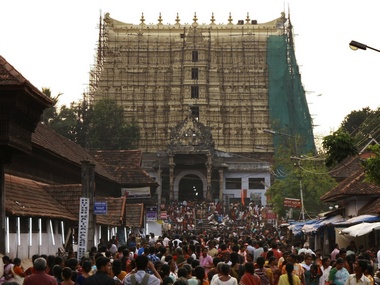The mystery over the “treasure trove” of the eighth century Padmanabhaswami Temple in Thiruvananthapuram is back in the city with the Supreme Court appointed expert committee beginning its evaluation of the temple assets this morning. After a preparatory-meeting at the temple, they have moved towards the “E” and “F” vaults even as a large number of onlookers and security-men gathered around the temple with bated breaths. The committee members are accompanied by the experts from the archaeology department. [caption id=“attachment_218782” align=“alignleft” width=“380” caption=“Padmanabhaswami Temple in Thiruvananthapuram. V Sivaram/Reuters”]  [/caption] The process is expected to last several days and an interim report will be filed in the Supreme Court. The experts will examine all the vaults of the temple, except the “A” and “B” vaults, enumerate the properties and make a modern inventory. An evaluation of the material-worth of the properties is unlikely for the time being. The experts today have started with the “E” and “F” vaults, although the initial plan was to open the “C” and “D” vaults, which reportedly comprise properties that are required for the routine rituals of the temple. However, a local court had sealed these two cellars and the committee would need to get them opened with the consent of the Supreme Court. The setting of the examination has an air of fairytale mystique. A modern control room has been set up with the support of the state-owned KELTRON near the sanctum sanctorum (shreekovil). Each item from the cellar, for instance the E-vault today, will be trolleyed to the control room under CCTV surveillance, bar-coded, photographed, including in 3D, video-recorded and inventoried. Recording of each item is likely to take at least 20 minutes. The assets will be sorted into three categories: those of art, archaeological and historical value; those for daily use; and those with economic value. The categorisation will help in economic evaluation in the future. However, the real treasure-trove is expected in the B-vault, which will not be opened anytime now. People close to the temple say the value of the contents of this cellar will surpass what was found in the A-vault, which had led to a world-wide sensation last year. The A-vault will also be examined along with the B-vault; but the committee will have to wait for a direction from the Supreme Court as well as the setting up of a strong room and security system that are compliant with the Reserve Bank of India guidelines. The temple; which has six underground vaults comprising jewels, vessels, precious stones, coins, statues and a lot of unaccounted items of enormous material and archaeological value; shot to national and then international prominence with a court petition from a devotee who wanted its assets to be enumerated and protected. A series of court procedures and a partial enumeration of the contents of one of the vaults (A) literally opened a pandora’s box with speculations pegging the assets at more than Rs 10,000 crores. It was followed by a lot of intrigue and drama, including a “devaprashnam” (divine prediction) by astrologers who warned against the opening of the B-vault. Apparently an image of a cobra is inscribed on the stone and iron walls of the B-vault warning that anybody tampering with its locks will die of snake-bite. The astrological intervention was allegedly to be a plot by vested interests against any further evaluation of the temple properties. The developments at the temple also had led to a divide between the left parties on the one side and the Congress and the BJP on the other. The Vishnu temple, bearing a typical dravidian architectural style, is part of the city cultural heritage for several centuries. The city also borrows its name from the temple.
The mystery over the “treasure trove” of the Padmanabhaswami Temple in Thiruvananthapuram is back in the city with the Supreme Court appointed expert committee beginning its evaluation of the temple assets this morning.
Advertisement
End of Article


)
)
)
)
)
)
)
)
)



